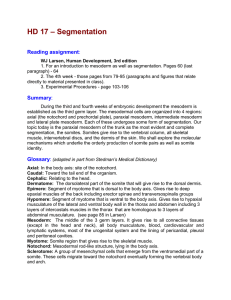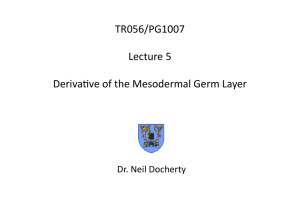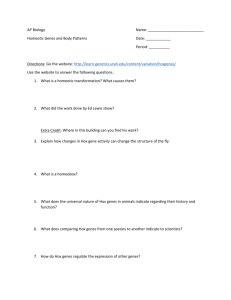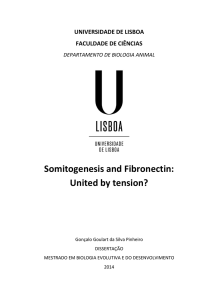Patterning the vertebrate body axis HD 3 Ed Laufer February 24, 2009
advertisement
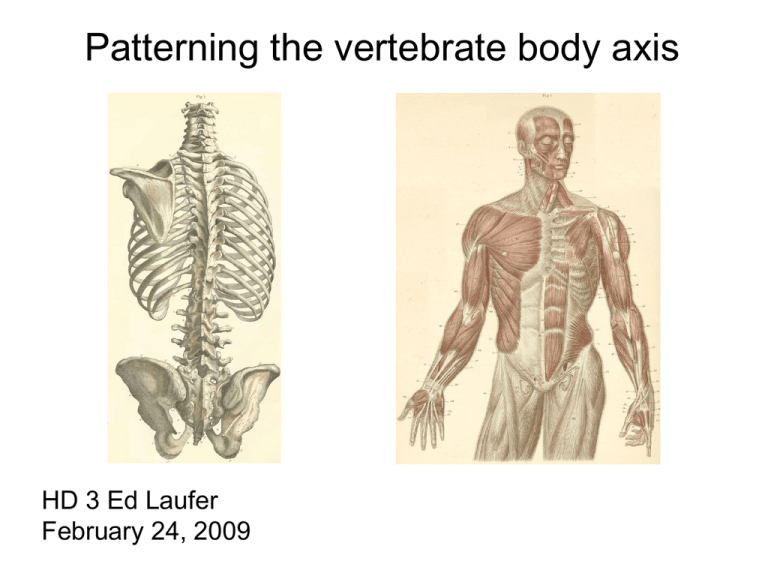
Patterning the vertebrate body axis
HD 3 Ed Laufer
February 24, 2009
Regional differentiation of
mesoderm
Axial
Paraxial
Intermediate
Somatic
Splanchnic
Chick embryo
Morphological changes at early postgastrulation stages
Segments organize the body plan during
embryogenesis
Drosophila
Human
Mouse
Chick
Zebrafish
Axial segments originate from somites
Somites are
precursors of:
Axial skeleton (ribs,
vertebrae)
Trunk/Limb muscles
Dermis
Axial tendons
Gilbert (2003)
Segmentation by sequential addition
Neural tube
A caudal growth
zone generates
new unpatterned
tissue.
somites
Older, more rostral
tissue, is allocated
into segments in a
rostrocaudal
progression.
Presomitic mesoderm
(unsegmented)
Rhythmic production of somites from the
presomitic mesoderm (PSM)
2-day old chick embryo
Lateral view of Segmentation
Somites form movie here
Rostral
Olivier Pourquie
Caudal
Somitogenesis is a reiterated process
S+2
S+3
Mature somites
Presomitic
mesoderm (PSM)
S+1
S+2
S0
S+1
Epithelialization
S-1
S0
Anterior/Posterior patterning
S-1
Segment border formation
Segmentation clock= periodicity
Wavefront= positional cues
Tail Extension
Oscillatory Genes Regulate Somitogenesis
Expression
of the
hairy gene
in chick
Palmerim et al.,1997
(Pourquié Lab)
Ish-Horowicz lab
animation
10
The Notch pathway underlies a
“Segmentation Clock” in the PSM
Hes1 promoter
Ub
Luciferase
Delta-like 1,3
PSM cell1
-secretase
PSM cell 2
Notch
NICD
Hes1,7
Lfng
Masamiza (2006) PNAS
The vertebrate segmentation clock
Alexander Aulehla and
Olivier Pourquie
Lfng promoter-YFP
10 hour movie
Two photon time
lapse imaging
Why does the signaling oscillator only lead to
segmentation at the rostral end of the PSM?
...because there is an inhibitory FGF/Wnt signal
produced at the caudal end of the embryo
The “Wavefront” sets up positional information
One round of somitogenesis 120 min.
Segmentation Clock
Wavefront
FGF8/WNT3a
Phase1
Phase 2
Phase3
Phase 1
The wavefront/determination front controls the
spatial response to the segmentation clock
Retinoic acid
signaling
Determination
Front
Differentiation
(Myf5, Pax1)
Segmentation
(Mesp2)
FGF/Wnt
signaling
Posterior identity
(Brachyury
Sprouty)
Mutations in the Notch pathway/segmentation
clock lead to congenital scoliosis
Mouse
Lfng +/+
Lfng-/-
Human
Lfng +/+
Lfng-/SPONDYLOCOSTAL DYSOSTOSIS,
AUTOSOMAL RECESSIVE 3; SCDO3;
OMIM 609813
Bulman Nature Genetics (2000)
Additional Congenital Vertebral Defects
JAG1-Alagille syndrome (OMIM
118450)
(64% display vertebral defects)
From Nancy Spinner and Ian Krantz
Congenital scoliosis & kyphosis
Uncloned, etiology not known
Erol et al., 2004
Coordinated temporal regulation of signaling modules of
the FGF, Notch and Wnt pathways underlies the
segmentation clock
ESomite
9.5 mouse
embryo
differentiation
Day 9.5 mouse embryo
1mm
Somites differentiate progressively: multiple stages
are present in the embryo at any time
Somites differentiate progressively
Epithelial somite
The sclerotome forms the
vertebrae, the myotome forms
muscles
By the end of the fifth week,
prospective muscles are
found divided into two parts:
Epimere - back muscles (from
dorsomedial lip of myotome)
Hypomere - body wall and
limb muscles (from
ventromedial lip of myotome)
Ribs and Sternum:
Unlike the rest of the axial skeleton (vertebrae and vertebral ribs,
the sternum derives from lateral plate mesoderm
Two sternal bands condense bilaterally in the lateral plate
mesoderm in the ventral body wall, migrate around the
developing embryo and fuse at the midline to become the
manubrium, sternebrae and xiphoid process
4th Somitic Compartment: The Syndetome
Defined by expression of
scleraxis (Scx).
This population arises
between myotome (after
involution under
dermomyotome) and
sclerotome.
From sclerotomal
compartment.
Scx
Gives rise to the
tendons.
Places tendons in correct position in the axial skeleton…
Resegmentation:
Cells from the caudal half of
one somite and cells from
the cranial half of the
adjacent caudal somite form
one vertebral body.
This allows the nerves of each
segment to project out of phase
from the vertebral bodies
The stereotypic pattern of somite development
a
presomitic
mesoderm (psm) cells
surface ectoderm
neural tube
notochord
b
somite formation
epithelialization
a
c
b
c
d
dermomyotome
sclerotome
medial myotome
central myotome
lateral myotome
Inductive interactions subdivide the somite
- Shh and noggin (BMP antagonist), secreted by the notochord and
floor plate cause the ventral part of the somite to form sclerotome
(Pax1 txn factor).
- Wnt, noggin (dorsal neural tube) and low Shh (notochord) induce
dermamyotome (Pax3).
- Wnts also direct the
dorsomedial portion of
the somite to form
epaxial (back)
muscles.
- NT-3 directs dermatome
differentiation.
- Hypaxial (limb and body
wall) muscles are formed from
dorsolateral portion of the
somite in response to Wnt and
BMP signaling.
Patterning the axial skeleton - specification of the
somite along the anteroposterior (AP) axis
Although the basic cellular differentiation pattern of somites at different
axial positions is very similar, unique vertebral structures form along the
craniocaudal axis, indicating that somites acquire specific identities
according to their axial position.
Axial identity is
regulated by Hox gene
expression
What are Hox genes?
A little bit of background...
Wild type fruit fly
T2 has a wing
T3 has a haltere (rudimentary wing)
(1) A fruit fly carrying a “homeotic
mutation”:
the third thoracic segment develops
like the second thoracic segment
(2) The fly leg and antenna are homologous
structures
Homeotic mutant with legs in place of antennae
“Antennapedia”
The homeotic genes are arranged in a cluster that
reflects the order of the body parts they regulate
Drosophila
Chromosome
lab
ANT-C
pb
Dfd
Scr Antp
Ubx AbdA AbdB
BX-C
3
They encode transcription factors that contain a conserved DNA
binding motif, the homeobox.
Vertebrates have homologous genes, arrayed along
four chromosomes: The paralogous Hox gene
clusters
Drosophila
Chromosome
lab
Dfd
pb
Scr Antp
Ubx AbdA AbdB
BX-C
ANT-C
Mouse/
Human
A1
A2
A3
A4
A5
A6
A7
B1
B2
B3
B4
B5
B6
B7
C4
C5
C6
A9
A10 A11
3
A13
Evx1
HoxA
B8
B9
B13
C8
C9
C10 C11 C12 C13
D8
D9
D10 D11 D12 D13
11
HoxB
15
HoxC
D1
D3
D4
HoxD
paralogs
6
Evx2
2
Vertebrate Hox axial expression patterns also
reflect their chromosomal order
Expression is progressively induced
during gastrulation, and the
expression patterns are nested in a
chromosomal and morphological
progression. This is called
“colinearity”.
The combination of Hox genes
expressed in a tissue forms a Hox
code.
Note that Hox10 paralogs have an
anterior (rostral) expression
boundary at the thoracic/lumbar
border, and Hox11 at lumbar/sacral
T13
}
*
*
{
* *
* *
*
{
*
C5
T13
}
Control
Sacral
S2
L3
T12
10aaccdd
Loss of paralogous function
results in complete loss of
regional identity in axial
column
‘Segment transformation’
Lumbar --> Thoracic
Lumbar
}
T13
S2
C5
T12
Wellik and Capecchi, Science, 2003
*
{
L3
11aaccdd
T12
* *
*
L3
S2
C5
‘Segment transformation’
Sacral --> Lumbar
Hox expression is conserved and boundaries correlate with
changes in vertebral morphology
Hox genes do not specify cartilage/bone directly
Rather they modulate the way skeletal progenitors respond
to other signals.
Similar to inductive signals, they are used repeatedly to
modulate pattern in many developing tissues.
Key Ideas (I):
The axial body plan is organized into repeating mesodermal structures
called somites
Somites form progressively from presegmental mesoderm at the caudal
end of the growing embryo, through a “clock and wavefront”
mechanism that involves Notch, FGF and Wnt signaling
Malfunctioning of this signaling system cause vertebral segmentation
defects
Somites are subdivided by inductive signals emanating from the
surrounding embryonic structures
Somites differentiate into axial skeleton, muscles, dermis and tendons
Key Ideas (II):
Cells at different cranial-caudal and different dorsal-ventral
locations in the embryo express different combinations of
transcription factors “telling” cells where they are and hence
modulating the structures they produce
Along the cranial-caudal (“anterior-posterior”) axis, Hox genes
provide a combinatorial code for cell fate
The homeobox is a highly conserved DNA-binding domain of the
Hox proteins
There are 4 clusters of Hox genes (A->D) with a total of 13 gene
families (low numbered Hox genes are expressed more cranially)
Hox genes are also used in adult cells as transcription factors that
regulate growth and differentiation, but not pattern


